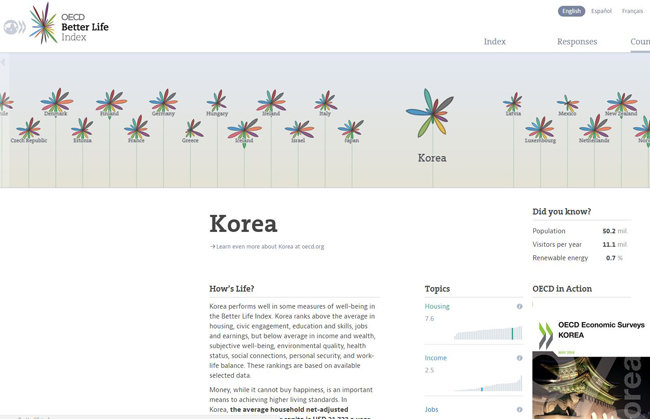![국민의 불꽃같은 행복을 위해 국가는 무엇을 해야 하는가. 사진은 2017년 부산불꽃축제. [박경모 동아일보 기자]](https://dimg.donga.com/ugc/CDB/SHINDONGA/Article/5a/5e/e2/5d/5a5ee25d0c93d2738de6.jpg)
국민의 불꽃같은 행복을 위해 국가는 무엇을 해야 하는가. 사진은 2017년 부산불꽃축제. [박경모 동아일보 기자]
GDP 외에 다른 측정지수 필요

알렉산더 바카위
행복은 또한 구체적인 상황과 맥락이 중요하다. 행복의 구성 요소들을 정의할 때 세계 여러 나라 사람들도 비슷한 생각을 하겠지만, 어떤 부분을 중시하느냐에 따라 변화가 있을 수 있다. 개인적 행복과 관련된 소득이나 건강, 사회적 연결망, 그리고 다른 요소들의 상대적 무게감은 지역과 시간에 따라 달라진다. OECD ‘더 나은 삶 지수’도 이 점을 인정하고 있다. 이 지표는 사용자들이 드러나지 않은 가중치를 개별화할 수 있게 해서 그들의 시각과 더 잘 동화되는 지표를 만들어낼 수 있도록 한다.
우선순위 측면에서 그런 차이점에도 불구하고 행복에 대한 포괄적인 측정은 온전한 정책 입안에 핵심적인 요소다. GDP에 대한 영향을 넘어서는 정책 대안들을 비교하는 것은 매우 중요하다. 이것은 서로 다른 목표들 간의 상쇄 부분을 어떻게 다룰 것이냐를 결정할 때 핵심적인 요소가 된다. 또 이것은 한 국가가 오늘과 내일, 바로 이곳, 그리고 어디에서든 개인의 행복을 발전시킴으로써 지속가능한 방향으로 가고 있느냐 아니냐를 따지는 기초를 제공한다.
훌륭한 경제 정책은 이 맥락에서 근본적인 지렛대 효과를 행사할 수 있다. 정부의 회계나 금융, 그리고 무역 정책이 행복에 대한 포괄적인 정의와 연동하는지 여부는 발전의 지속가능성 측면에서 중요한 영향을 미친다. 하지만 오늘날 이런 것들이 서로 연동되지 않는 경우가 너무나 많다. 세계 각국이 수십억 달러를, 목표 달성에 비효율적이고, 종종 사회적·환경적 부작용을 일으키는 세액 보조용으로 투입한다는 사실은 매우 심각한 일이다. 중앙은행은 그 개입의 결과가 얼마나 심각한지에 대한 아무런 논의도 없이 수조 달러를 금융시장에 투입한다. 그뿐 아니라 수십 년 동안 무역 자유화로 손해를 본 사람들에게 아무런 관심을 보이지 못하고 있는 현실 아닌가.
지속가능한 정책은 오늘의 행복을 키우는 동시에 내일의 국민 삶을 개선하기 위해 자원을 쌓아둔다. 이들 정책은 그러한 진전이 국가경제 내에서 광범위하게 공유된다는 것을 보증한다. 또 그런 정책은 한 국가가 번영을 이루는 목표가 있다 해도 다른 나라가 삶의 기준을 높이는 능력을 줄이지 않는 선에서 해야 한다는 것을 포함한다.
그런 점에서 정책의 일관성은 매우 중요하다. 행복은 모든 정책 영역을 통해 영향을 받는다. 그래서 전반적으로 종합적인 정책 목표로 통합돼야 할 필요가 있다. 경제 정책, 교육 정책, 에너지 정책, 외교 정책, 혹은 다른 어떤 정책 분야에 집중하더라도 번영에 대한 개괄적인 정의는 일종의 ‘안내별(guiding star)’이 돼야 한다. 정책 대안에 대한 포괄적인 분석과 행복에 대한 그 영향이 논쟁의 방향을 이끌어야 한다. 그리고 GDP를 넘어서는 측정에 대한 주기적인 보고가 책임의 척도가 돼야 한다.
일자리 불안정성 점점 높아져
더욱이 시너지 효과를 확보하고, 나이·성·지역뿐 아니라 세대를 아우르는 기준에 따른 사회 각 부문 간, 서로 다른 목표 간의 상쇄를 다루는 문제가 핵심이다. 교육과 소득 간의 긍정적 관계, 개인의 안녕에 대한 불평등의 부정적 영향, 그리고 미래 세대를 위해 자연 자원을 보호할 필요성 같은 것이 바로 그런 사례들이다. 조세와 무역 등의 분야에서 국제 공조는 국가 간 의도치 않은 파급효과를 줄이는 데 중심축이 된다.지난 수십 년간 전 세계적으로 번영과 삶의 기준이 많이 높아졌다. 2000년과 2015년 사이 세계의 평균 인간개발지수는 12% 상승했다. 지난 3년간 128개국 가운데 113개국이 사회발전지수에서 진전이 있었다. 2005년을 기준으로 비교하면 OECD 국가 대부분이 평균 가계소득이 높아졌고, 기대수명도 2년이나 늘어났으며, 많은 사람이 밤에 혼자 걸어도 치안이 안전하다고 말하고 있다.
물론 동시에 해결해야 할 많은 일이 남았다. 지속가능발전목표는 기본적 욕구를 충족하는 데 국가 간 큰 차이가 있음이 확인된다. 생태발자국 데이터에 따르면 전 세계 인구의 80% 이상이 자연이 회생할 수 있는 정도의 생태 자원과 서비스보다 훨씬 많은 것을 사용하는 나라에 살고 있음을 새삼 확인하게 된다. OECD 국가에서 일자리 불안정성은 지난 10년간 3분의 1이나 높아졌다. 평균 삶의 만족도는 낮아졌으며, 친구와 가족으로부터 지지를 받고 있다는 연대감을 느끼는 사람이 3%나 줄어들었다. 무엇보다 불평등성이 1980년대 중반 수준보다 상당히 높아졌는데, 이러한 점은 평균적 분석이 행복지수 측정에 부적합하다는 것을 뚯하기도 한다.
이러한 난제들을 해결하기 위해서 국가 정책은 번영에 대한 포괄적인 개념과 연동될 필요가 있다. 정책을 세울 때는 GDP 개념을 넘어서 ‘사회적 가치’ 등 더 다양한 요소를 고려해야 한다. 그리고 지속가능한 길을 만들기 위해 모든 정책 분야에서 일관성을 유지해야 한다. 그래야 그 길에서 더 많은 사람의 삶은 비로소 더욱 좋아질 수 있다. 바로 오늘과 내일, 이곳이든 어디에서든.
OECD 더 나은 삶 지수… 한국은?
삶의 만족도 5.9(평균 6.5)…선진국 평균보다 못살고 사회 지원 최저

한국은 소득과 부의 요소에서 OECD 평균보다 낮은 반면 장기실업률은 최저 수준이고, 노동시장 불안정성도 낮다. 업무 스트레스는 최고 수준이며, 수입과 취업률은 평균보다 낮다. 집을 보면 1인당 방의 수와 기본적 위생시설도 평균보다 낮다. 주택구입능력지수는 최고 수준이다. 기대수명은 82세로 OECD 평균보다 높지만 32%의 한국인만이 자신의 건강이 좋다고 느끼고 있다. 교육과 기술 부문에서는 경쟁력을 갖고 있지만 사회 지원과 환경의 질(특히 공기)은 최저 수준이다.
더 나은 삶 지수는 행복에 대해 포괄적인 그림을 보여주고, 국가 간 비교가 가능하게 한다. 분석 요소는 11개. 소득과 부, 일과 수입, 집, 건강, 일과 삶의 균형, 교육과 숙련된 기술, 사회적 연결망, 시민으로서의 관여와 거버넌스, 환경의 질, 개인적 안전, 주관적인 행복 등이다. 이 지표는 또 장기간 행복을 유지하는 데 도움을 주는 네 가지 자원도 들여다본다. 즉 자연·인간·경제·사회 자본이다. - 정현상 기자
How’s Life?
Last month, the OECD published its most recent report on a short but fundamental question: How’s Life? Income is an important, but not the only factor in determining the answer. The OECD reflects this by going beyond the focus on GDP, that has for long been dominating economic debates, with a “Better Life Index” which also accounts for health, social connections, personal security, environmental quality and further criteria.
The recognition that human well-being is multi-dimensional and thus cannot be measured by GDP alone is gaining ground worldwide. Growing endorsement of indicators such as the Human Development Index, the Social Progress Index, and the Sustainable Development Goals Index are a case in point.
Well-being is also context-specific. While people across the globe have significant overlap in defining its components, they differ in the importance they attach to each of them. The relative weights of income, health, social connections and other factors in personal well-being change across space and time. The OECD Better Life Index acknowledges this by allowing its users to customize the underlying weightings and thus come up with an indicator that may be better aligned with their views.
Such differences in priorities notwithstanding, a comprehensive measure of well-being is key to sound policymaking. It is critical to compare policy alternatives beyond their impact on GDP. It is at the core of determining how to deal with trade-offs between different goals. And it provides the foundation to explore whether current policies are sustainable by fostering well-being today and tomorrow, here and elsewhere.
Economic policy is a fundamental leverage point in this context. Whether countries align their fiscal, monetary and trade policies with a comprehensive definition of well-being has significant ramifications for people and the planet. Today, misalignments abound. The fact that governments worldwide offer billions of dollars in tax credits that are often ineffective in reaching their goals, and frequently trigger negative social and environmental side effects, is a sobering example. The decision by central banks to inject trillions of dollars into financial markets without a debate on the distributive consequences of these interventions, as well as the lack of attention that was paid in the last decades to those losing out from trade liberalization provide further illustration.
Sustainable policies foster well-being now while at the same time building up and sustaining resources to improve people’s lives tomorrow. They also ensure that progress is widely shared within an economy. And they reflect the goal to advance national prosperity without reducing the ability of other countries to raise their own living standards.
Policy coherence is critical in this regard. Well-being is affected through all policy fields and thus needs to be integrated as an overarching policy goal across the board. Whether one zooms in on economic policy, education policy, energy policy, foreign policy, or any other policy area, a broad definition of prosperity must be the guiding star. Comprehensive assessments of policy alternatives and their impact on well-being should steer debates. And regular reporting on measures beyond GDP should be the yardstick for accountability.
Furthermore, seizing synergies and dealing with trade-offs between different goals, segments of society according to criteria such as age, gender, and region, as well as across generations is key. The positive relation between education and income, the negative impact of inequality on personal security, and the need to protect natural resources for future generations are cases in point. International coordination, e.g. in the field of taxation and trade, is an important pillar to reduce unwanted spillover effects between countries.
The recent OECD report highlights several aspects of well-being that have improved over the last decade. Most OECD countries today have higher average household incomes than in 2005, average life expectancy has increased by nearly two years and more people say they feel safe when walking alone at night. At the same time, many people have not benefitted from the recovery since the financial crisis. Job insecurity in the OECD has risen by a third, average life satisfaction is lower and the share of people who feel supported by friends and family has gone down by 3 percentage points. Moreover, inequality remains well above levels in the mid-1980s – pointing to the fact that OECD averages may often be a poor indicator for well-being across the population. Globally, environmental trends – such as the continued growth in resource consumption and greenhouse gas emissions – give further reason for concern.
Over the last decades much has been achieved to raise prosperity and living standards across the world. At the same time, much remains to be done to stay on this trajectory and thus to ensure that life is good for a growing number of people. Sustainable policies are at the heart of making this happen – today and tomorrow, here and elsewhere.




















![[밀착취재] 리딩방 70여 명 대부분이 한통속…기망하는 수법까지 매뉴얼화](https://dimg.donga.com/a/380/211/95/1/ugc/CDB/SHINDONGA/Article/69/48/98/bd/694898bd2399a0a0a0a.jpg)


![[지상중계] 제12회 나지포럼, “북미 정상회담 성과내기 어려워”](https://dimg.donga.com/a/380/211/95/1/ugc/CDB/SHINDONGA/Article/69/43/48/32/69434832107aa0a0a0a.jpg)
